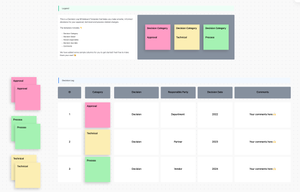Making decisions is the most important part of any project or process. But without the right tools to track and log those decisions, it can be hard to stay on top of their impact. That's why ClickUp created the Decision Log Template—to keep all your decision-making in one place!
The Decision Log Template makes tracking decisions easier by helping you:
- Document each decision and its rationale
- Monitor progress quickly with a dedicated timeline
- Analyze outcomes to see what works best for future decisions
This template is designed to be a comprehensive tool that enables better decision-making from start to finish. Give it a try today and see how it can help your team make smarter, faster decisions!
What Is A Decision Log?
A decision log is a tool that is used to record and track decisions made by a team or organization. It provides a centralized place to store all the decisions made, along with associated discussions, outcomes, and any other relevant information. By keeping these records in one place, it becomes easier for teams to refer back to past decisions when making new ones.
The decision log should include details such as the date of the decision, the person who made it, the reason why it was made, any alternatives considered, and the outcome. This helps teams to understand why certain decisions were made and to ensure that similar choices are not repeated. Keeping an accurate and up-to-date decision log can also identify potential problems or areas for improvement in organizational processes.
Benefits of a Decision Log Template
A decision log is a useful tool for tracking decisions made within an organization or team. It provides a way to keep track of the decisions that have been made, the rationale behind them, and any follow-up actions needed. This log helps to ensure that important decisions do not get lost in the shuffle of daily activity.
The benefits of using a decision log template are numerous. It can help:
- Provide a central repository for all decisions made by the organization
- Improve transparency, allowing project stakeholders to better understand why decisions were made
- Facilitate communication between teams and departments
- Identify areas where additional information or research is needed
- Assist with planning and forecasting by enabling team members to review past decisions
What Are the Main Elements of a Decision Log Template?
When making strategic decisions in your business, it's important to document why each one was made and who was involved. The elements of a Decision Log Template should include:
- Date and time of the decision
- What the decision is, including options considered
- The rationale for the decision
- Who approved it and who else was involved
- Timelines for implementation
- Any risks associated with the decision
- Follow-up measures to track progress
Organize all these aspects with ClickUp's free Decision Log Template, so you have all the info you need at your fingertips.
How to Create and Use a Decision Log
Making informed decisions is a critical part of running a successful business. To keep track of important decisions and the process used to reach them, it helps to use the Decision Log template in ClickUp:
1. Initialize the document.
Create a Whiteboard in ClickUp for your decision log and add information such as the date and name of the project. Make sure to leave space for additional details that will be added later on.
2. Identify stakeholders.
List all of the individuals who have an interest or stake in the decision-making process and who might be collaborating together. This could include key decision-makers, people affected by the outcome or those providing input or advice during the process.
Use tasks in ClickUp to list all stakeholders involved with each decision.
3. Determine objectives.
Determine what your overall goal is for this particular decision and break it down into more specific objectives if needed. This will help ensure that everyone associated with it is clear on what you’re trying to achieve and can work towards accomplishing it effectively.
Create custom fields in ClickUp to make sure all objectives are listed in one place.
4. Brainstorm ideas & options.
Gather ideas from team members, including those who may not be directly involved with making a particular decision but might have insight into it nonetheless (for example, someone from another department). Brainstorm together and come up with as many potential solutions or approaches as possible—the more options you have, the better off you’ll be
Use Docs in ClickUp to collaboratively brainstorm ideas and potential options with team members across departments—and keep conversations organized with threaded replies!
5. Consider consequences & risks associated with each option presented.
Analyze every option discussed thoroughly before deciding which one is best suited for your situation—considering any risks or repercussions associated with each one can also help narrow down your choices significantly
Use Checklists in ClickUp tasks so you can easily check off any potential consequences/risks associated per idea/option presented whenever necessary—and get notified when all have been addressed!
6. Make a final decision & document reasonings behind choices made.
Once you’ve identified which option best fits your needs and meets your desired objectives, go ahead and make your final decision! Be sure to document any rationale supporting this choice once it’s been finalized so that there’s no confusion regarding why it was made when looking back on it later on down the line.
Store all relevant info securely within ClickUp's encrypted cloud storage!
Troubleshooting Common Mistakes with a Decision Log
When troubleshooting, it is easy to make mistakes that can lead you down a path of frustration and wasted time. Common troubleshooting mistakes include:
- Failing to document the decision-making process
- Not gathering enough data or information when making a decision
- Making decisions without considering the impact on stakeholders
- Relying too heavily on one source of information
- Not reviewing and updating the log regularly
Related Templates



